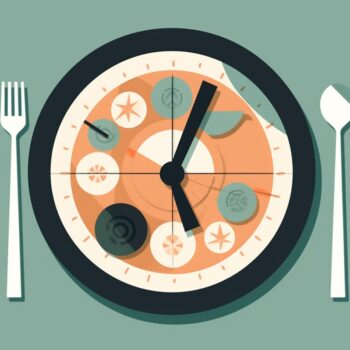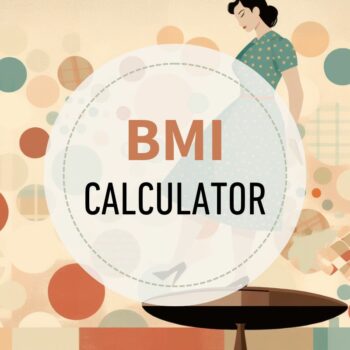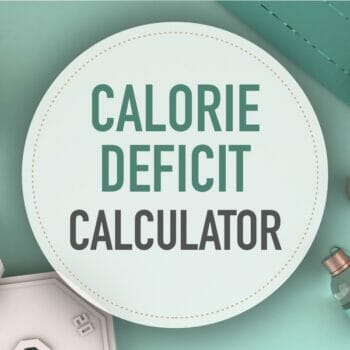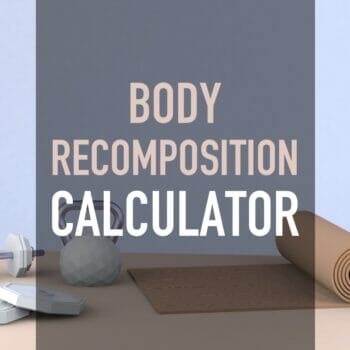Macro Calculator
This free, easy-to-use macro calculator gives you your optimal macronutrients and calories. It’s a weight loss or muscle gain calculator for both women and men.
Combine with macro counting or flexible dieting to reach your goals faster.
How to get leaner and stronger?
Our comprehensive macro-based fat loss program shows you how. Learn more
How do macros work?
The foods we eat are made up of three macros (macronutrients). These are carbohydrates (carbs), protein, and fat.
Chicken is high in protein but has no carbs; rice is high in carbs but has very little fat or protein. The three macronutrients provide the body with energy and raw materials for growth and repair.
By calculating the appropriate daily calorie amount for you, we can then break this down into the best macronutrient ratios to achieve weight loss.
Basic steps for macro counting
- Enter details into the calculator
Make sure to choose the correct goal. - Take note of your calories and macros
These will be the targets you are aiming for each day. - Track your macros
Use an app or pre-plan your meals. - Measure results
Don’t use basic weight scales.
Use proper body composition scales (we recommend Renpho) to measure fat and muscle mass changes.
What is a good macro ratio for fat loss or muscle gain?
Your macros should be based on your Total Daily Energy Expenditure (TDEE) and goals.
The calculator defaults to the best macro ratio proven to work for most people.
This ratio is:
- 30% fat
- Protein is 0.65 grams per pound of body weight,
- The remainder is carbs.
Depending on your goal, this will be either a calorie deficit or a surplus.
You can go further and make more adjustments: Perhaps you’re an extreme endomorph and do better with fewer carbs. Or perhaps you have one kidney and need to eat less protein.
You can fine-tune your results with a bit of math. See how to change your macros here.
What is a good protein ratio?
Rather than a percentage, proteins are based on your body weight. Our calculator has three settings:
- Moderate adjusts the ratio to 0.65 grams per pound of body weight.
This is appropriate for sedentary individuals or people with higher body fat percentages. - High is for active people with moderate strength training and an average body fat percentage.
- Maximum will set the ratio to 1 gram per pound.
This amount is good for bodybuilding and gaining muscle mass. You must be doing intense training.
Find out how to fine-tune your protein ratios when counting macros
Fat macro ratio
Set fat at 30% of daily energy expenditure.
Most people do very well with this amount of fat. See more about choosing the best macro fats. Because of high-fat diets like keto, many people are now eating more fat than they need to.
Carbohydrate macro ratio
Once you’ve calculated protein and fat, the remainder of your daily calories should be from carbohydrates.
Carbs fuel your body and workouts – and are the body’s preferred energy source.
If you are coming from a low-carb background, this may seem high. However, according to respected nutritional research, this is a moderate amount of carbs.
If you are eating according to your TDEE, the notion that carbs cause weight gain or stop fat loss is incorrect.
Using as a Calorie Deficit Calculator
As a weight loss calculator, this tool establishes a safe calorie deficit only.
The Lose option puts you in a 20% calorie deficit, promoting safe, steady weight loss.
The best macro ratio for body recomposition
If you want to recompose your body (lose fat and gain muscle simultaneously), then use the body recomposition calculator.
Macro ratio for maintenance
The Maintain button shows you the macro levels to maintain your current weight.
This is great if you have lost weight and don’t want to gain it back.
Macro ratio for muscle gain
The Gain button puts you in a 20% calorie surplus.
The macro breakdown is designed to build muscle fast in conjunction and must be combined with a comprehensive weight training program.
Underweight people can also use it.
TIP: Try starting with the maintenance goal and gradually increasing calories if you want lean muscle gains.
Calculating macros using your body fat percentage
The calculator uses your body weight to determine calories and macros.
However, you can obtain superior results by using your body fat percentage. The calculator allows you to choose which method: Normal for body weight, Lean Mass for fat percentage.
When to choose the Lean Mass Formula
If you are lean (have a low body fat percentage), choose the Lean Mass formula and enter your body fat %.
If you are classified as obese and have a lot of weight to lose, the lean mass formula is superior. You can read more about macro counting and obesity.
Help? Calculate your ideal body weight or get an assessment of your body fat percentage.
Why the difference? Muscle cells burn more calories than fat cells, so the more accurately we measure this, the better your results will be.
How to calculate macros per meal
You can break this down into meals once you’ve calculated your daily macros in the calculator.
Choose from 2 to 6 meals daily to see the macro ratio you can track for each meal. For some people, this is easier, but for others, this is too much detail.
Do what works for you.
Meal Plans
See a 5-day macro-based meal plan. It includes three meals and two snacks per day.
Macro calculator activity level settings
A higher activity level means a higher daily calorie goal.
For example – if you maintain your weight at 2,000 calories per day, adding vigorous daily exercise means you need more calories to maintain your weight.
If you are sedentary and trying to lose weight, adding exercise will increase your daily calorie goal.
The idea seems counter-intuitive, but more energy is required to fuel your workouts. More workouts lead to increasing metabolism; therefore, more fat is burned!
Undereating is one of the leading causes of the weight loss plateau.
So many of our clients previously “hit the wall” with dieting. They would continually reduce calories, stop losing fat, and gain weight when they eat a little more.
Macro counting defeats this by prescribing the right food and calorie levels.
Which activity level do I choose?
- Sedentary: Just regular everyday activity like a bit of walking, a couple of flights of stairs, eating, etc.
- Light: Any activity that burns 200-400 calories (females) or 250-500 calories (males) over your sedentary amount.
- Moderate: Any activity that burns 400-650 calories (females) or 500-800 calories (males) more than your sedentary amount.
- Extreme: Any activity that burns more than 650 calories (females) or more than 800 calories (males) in addition to your sedentary amount.
Other options for determining your calorie burn
- Use our calories burned calculator – it accurately assesses over 380 activities.
- Use a fitness tracker – like a Fitbit or Apple Watch (note that they can overestimate calorie burn).
- Use a suitable app – like MapMyFitness
Why should I eat more when I exercise more?
High physical activity not fueled with enough calories will lead to muscle catabolism (breakdown of muscle fiber).
This lack of nutrition could stall your weight loss, so eat up if you love to exercise!
I’ve got my macros – now what?
Once you’ve identified your target daily macros, you must determine the macros in all your foods.
By tracking them daily, you can reach your recommended macro targets that encourage fat loss, muscle gain, or whatever your goal may be.
You can learn more about the macro counting system and the flexible dieting philosophy. Many people use an app like Myfitnesspal to track macros.
For more specifics on what to eat – see a sample macro meal plan or a list of macros for familiar foods.
View article sourcesSources
- Mifflin, M. D., St Jeor, S. T., Hill, L. A., Scott, B. J., Daugherty, S. A., & Koh, Y. O. (1990). A new predictive equation for resting energy expenditure in healthy individuals. The American Journal of Clinical Nutrition, 51 (2), 241-247. Link
- McArdle, W. D., Katch, F. I., & Katch, V. L. (2010). Exercise physiology: nutrition, energy, and human performance. Lippincott Williams & Wilkins. Link
- Jequier, E. (1994). Carbohydrates as a source of energy. The American journal of clinical nutrition, 59(3), 682S-685S.
- Lemon, P. W., Tarnopolsky, M. A., MacDougall, J. D., & Atkinson, S. A. (1992). Protein requirements and muscle mass/strength changes during intensive training in novice bodybuilders. Journal of Applied Physiology, 73(2), 767-775. study abstract link
- Grundy, S. M. (1999). The optimal ratio of fat-to-carbohydrate in the diet. Annual review of nutrition, 19(1), 325-341. abstract
- Conlin, L.A., Aguilar, D.T., Rogers, G.E. et al. Flexible vs. rigid dieting in resistance-trained individuals seeking to optimize their physiques: A randomized controlled trial. J Int Soc Sports Nutr 18, 52 (2021). https://doi.org/10.1186/s12970-021-00452-2
2,104 Comments


 Menopause Macro Calculator
Menopause Macro Calculator Intermittent Fasting Calculator
Intermittent Fasting Calculator BMI Calculator
BMI Calculator Calorie Deficit Calculator
Calorie Deficit Calculator Body Recomposition Calculator
Body Recomposition Calculator
Hey there! I am confused and looking for some advice. I am a 36 year old female at 5′ 8″ and about 115lbs, looking to put on a little weight since this is under weight for my frame. I am a runner, running average 5 days a week at an average of 4-5 miles a day. I have calculated my macros at lightly active. Currently I am working With my calculated macros, am I to input that into MyFitnessPal for tracking purposes? If my Garmin is linked to MyFitnessPal and I “earn” macros/calories from my activity, am I to include those macros/calories in my daily goal or keep it at what was calculated via your calculator?
Currently set at 2000 cal.
200c/150p/66f
Any advice you can give would be greatly appreciated!
Thank you!
Hi, I am confuse. Everything I know states that there needs to be a calorie deficit in order to loose weight. Calories need to be reduced so why am I getting such a high number of calories needed? It sounds way too high for me. I am recovery from an injury and have been inactive for 4months. I have gained 20lbs of post competition weight gain and I am desperately trying to loose them again. I don’t know what I should my total calorie intake should be. Could you please give me some clarity and guidance here. Nothing I did to prep for competition is working. Have I been under eating for too long? Feel like my body is working against me.
Eating between 800-1000 calories a day. I’m 43, 5’3″, 140lbs and burn 200-400 calories a day their cardio and strength training. Currently eating 70-100g of Carbs, 30g of Fat and 120protein
Hi Ted. I was just recc to your site and loving it so far! I am 30 years old 5’8″ and 142 lbs and I would consider ‘light activity’ – (workout 6x a week for 30-40 minutes high intensity with some weights) I have been counting macros for a while and using 1632 cals, 135p, 147c and 56f. I would like to loose a little bit of weight but more so be more defined and less bulky from weight lifting. This calculator is setting my protein much lower than what I have followed and carbs much higher. Is that accurate or should I adjust? What I have been following has not changed the number on the scale at all so open to adjusting but always thought protein should be high. Thanks!
Hi Whitney, Thanks and I’m glad you find it useful. Based on your activity, you don’t need more protein than 1 gram per pound of body weight. You can set the calculator on the high setting to factor for this. You also may want to check your activity level because you may be on the borderline. Less isn’t always best and long periods of undereating can cause weight loss stalls. Do you know about how many calories you burn during a typical workout?
Hi Ted. Thanks for the quick reply! -That’s awesome.
I am not sure I am following what you are saying…. when I put in my stats in your calc above add ‘light activity’ (I have a desk job outside of the 6 workouts I do a week) and ‘normal’ protein and 10% loss I am getting 1750 cals 211c 117p and 49f. As mentioned above this is a lot less protein and a lot more carbs than what I have been eating previously. Would this be a good tweak for weight loss? I wear a heart rate monitor when I workout and I am burning roughly 400-500 cals per workout. Your additional suggestions would be great. Thanks!!
Hi Whitney, If you were just factoring for your desk job you would choose sedentary. But since you burn an additional 400-500 calories per workout you would choose moderate ( see the explanation of activity levels in the article above.) on a rest day eat at sedentary levels. Once you have your results click on High for protein and it will adjust your protein higher.
Height 5’5″
Hi Ted,
I am so excited to have found your website as it’s full of so much useful advice and information! I wanted to know if I have done the math correctly for toning/fat loss/ strength. I currently weigh 122lbs, 38yrs, I workout 5/week to this routine: Monday: legs & Butt
Warm Up Wide Stance Bodyweight Squat: 2 sets x 15-20 reps
Wide Stance Barbell Squat: 4 sets x 8-12 reps
Romanian Deadlift: 4 sets x 8-12 reps
Glute Bridge: 4 sets x 15-20 reps
Glute Kickback: 4 sets x 15-20 reps (each leg)
Tuesday: Upper Body
Warm Up Bench Press: 2 sets x 15-20 reps
Bench Press: 4 sets x 8-12 reps
(Knee) Push Ups: 4 sets x 8-12 reps
Lat Pulldown: 4 sets x 12-15 reps
Wednesday: Core & LISS Cardio
Warm Up Crunches: 2 sets x 10 reps
Roman Chair Leg Raise: 4 sets x 10-15 reps
Roman Chair Oblique Leg Raise: 4 sets x 10-15 reps (each side)
LISS Cardio – 20-30 minutes
Thursday: Legs & Butt & Calves
Warm Up Stiff-Legged Barbell Deadlift: 2 sets x 15-20 reps
Stiff-Legged Barbell Deadlift: 4 sets x 15-20 reps
Glute Bridge: 4 sets x 15-20 reps
Reverse Lunge: 4 sets x 8-12 reps (each leg)
Standing Calf Raise: 4 sets x 12-15 reps
Friday: Upper Body + HIIT Cardio
Warm Up standing Barbell Shoulder Press: 2 sets x 15-20 reps
Standing Barbell Shoulder Press: 4 sets x 8-12 reps
Side Lateral Raise: 4 sets x 12-15 reps
EZ Barbell Bicep Curl: 4 sets x 12-15 reps
Tricep Dips: 4 sets x 12-15 reps
HIIT Cardio – 10 rounds – 20 seconds of work – 40 seconds of recovery
What activity level would this be? Have I chosen the correct macro settings for workout days to be:
1500 calories/day
161g carbs
122g protein
42g Fat
Thank you and I apologize for the mass info.
Hi Wendy, Glad you found our site too! It seems like you’d be between moderate and lightly active. Also, since you are at a healthy weight and just want to be more defined, toned, but add strength you probably should just be in a 10% calorie deficit. Based on your numbers and goals it seems like you should be eating a little more than what you’ve calculated.
Thank you so much Ted for your prompt response! I will definitely be recalculating
Hi,
I have been counting my macros on and off for a couple years but probably haven’t stuck to it strict enough for long enough or I am not finding the right macro/calorie balance. I want to lean up/lose fat and gain strength. I don’t really care what the number on the scale is but I know I’m carrying a few extra pounds or percent body fat right now. I am an elementary teacher, pretty active and I attend CrossFit average 4 times a week for exercise. I do like to push myself at the gym, tracking to increase max lifts and endurance. Would that be light or moderate activity?
Hi Lisa, Usually CF is moderate as long as you are pushing yourself for the hour. Make sure you also calculate a rest day set of macros for your non-CF days.
Thank you! Rest days would be sedentary? Also, generally how long does one follow the 10% loss plan before switching to maintenance? Should there be a predetermined goal weight to hit? I ask because I guess I should weigh about 5 pounds less but I’m not really sure. Over the last couple years I actually weigh more than I used to but I’m about 2 clothing sizes smaller and overall much more fit. I like the way I looked best at about 132ish and I hover around 137 right now but when I was at 132 I was only eating about 1200-1300 cals a day (no macros) and I lost a lot of muscle and all my lifts and endurance times suffered.
Yes, rest days are sedentary. You would switch to maintenance when you have lost the five pounds. At 132 your maintenance calories would be around 1500 on rest days and 1950 on exercise days.
Hi Ted!
Back again with a different take physically and mentally about this nutrition thing. I was unable to sustain the routine I had and in the mess of it all I had developed some very bad habits. Just trying to regroup, so I’ve started the Couchto5K app, so I’ve been doing 45ish of this cardio (walk/run) 6 days a week with a sprinkle of some bodyweight routines or 20 minute workout videos I find on YouTube here and there but not every day. Would that put me still at the sedentary level or would that put me at light activity?
Hi Ashley, Welcome back! It would definitely be light activity and possibly moderate depending on your calorie burn. 45 + 20 is 65 minutes of exercise. This often is moderate as long as it’s vigorous.
Hi, please advise me on activity level. I’m a female 35yrs mother. I have been strength training and working on competing in a year in powerlifting. I workout strength training 5 x per week 1-1.5hrs per session including warm up and stretching. Walking anything 2-6 x per week 60mins. Current PB Deadlift 100kg Squat 90kg Bench 60kg.
Want to check activity level and should my protein be high for strength purpose but burn body fat percentage.
Thanks
Hi Catherine, It seems like on days you walk and do powerlifting you’d be very active. Days that you just walk would be moderate. If you have days that you just powerlift that would be moderate as well. It would probably be wise for you to use several sets of macros. Yes, you should be at the highest protein setting.
Hello! I’m finding the info on this site to be very helpful, as I’m just starting to look at tracking macros. I am a 36 year old female and currently weigh about 155 lbs. I weight-lift 3 days a week (primarily I do the original Beach Body P90X program, which is around 45-60 minutes of weight-training each time), and do 2-3 days a week of very high-intensity cardio (between 30-60 minutes). I’m a mom, and with the exception of when I’m driving my kids around in the car, I’m on my feet much of the day. I was trying to decide if I should put in “moderately active” or “very active” in the calculator. I was leaning more toward very active, but wasn’t sure.
Also, how do vegetables fit into counting macros? I haven’t been able to find much about it yet, other than some vegetables are considered “free” and some–like peas and corn, for example–would obviously be considered carbohydrates. Is there a good list somewhere that would give me an idea of how most are counted?
Hi Alyssa, Glad you’re considering tracking macros! If you do those activities on separate days I would say go with moderate. You can always increase this if you feel you aren’t quite getting enough as you go. With vegetables, all vegetables should be tracked. You should also be tracking your fiber intake and it’s important for that as well as tracking your overall energy intake. Some veggies are low in calories but they still provide some energy.
Hello, Ted
I’d like to know how does the body-fat percentage contribute to the “basic formula”? For example:
((10 x weight (kg) + 6.25 x height (cm) – 5 x age (y) + 5)*1.55)*1.2
this is the formula for moderate activity male trying to gain weight, but where does the body fat percentage go in this equation, in order to get “lean mass” macros? I do know, that protein is tied to the bodyweight, and fat stays at 25% total calories, it’s just interesting how and why carbohydrates change in “normal” and “lean mass” calculators. Or they are completely seperate formulas?
They are completely separate formulas.
Could you possibly reveal the formula? Only I need it for is academic purposes.
The lean mass formula uses research from the Katch McCardle formula.
Where BMR = 370 + (21.6 * LBM)
LBM = Lean Body Mass which is derived from Body Fat % * weight.
Things don’t add up here.
For example, for weight 62 kg and 11% body fat.
370 + (21.6 * (11 * 62)) = 15101.2
LBM = 62kg – (62*.11) = 55.18
BMR = 370 + (21.6 *55.18) = 1561
Thank you very much!
Hello, Ted
I’d like to know how does the body-fat percentage contribute to the “basic formula”? For example:
((10 x weight (kg) + 6.25 x height (cm) – 5 x age (y) + 5)*1.55)*1.2
this is the formula for moderate activity male trying to gain weight, but where does the body fat percentage go in this equation, in order to get “lean mass” macros? I do know, that protein is tied to the bodyweight, and fat stays at 25% total calories, it’s just interesting how and why carbohydrates change in “normal” and “lean mass” calculators.
Good evening, I am trying to put my height in and it keeps telling me to put in a valid height. Well I am. I am 5’2″ and it won’t take it. Please help
Eboni
Hi Eboni, Your height has to be inputted in inches or centimeters. 5’2″ is 62 inches.